Infantry support squad
Apparently, by the spring of 1942, Ginzburg managed to reach the leadership of NKTP. The special bureau was instructed to design a single chassis for self-propelled guns using automotive units and T-60 tank units. Based on this chassis, it was planned to create an 76-mm self-propelled infantry support weapon and an 37-mm anti-aircraft self-propelled gun. In May-June, the 1942-th prototypes of the assault and anti-aircraft SAU were manufactured by plant No. 37 NKTP and entered the tests. Both cars had the same chassis, in which there were units of tanks T-60 and T-70. The tests were generally successful, and therefore in June 1942 of the year, the State Defense Committee issued an order on the speedy finalization of the machines and the release of the first production batch for military trials. However, large-scale battles that soon unfolded on the southern flank of the Soviet-German front demanded that NKTP enterprises increase the production of tanks and work on self-propelled guns turned.
Back to the development of installations back in the fall of 1942-th. October 19 T-bills decided to prepare the serial production of assault and anti-aircraft missiles caliber from 37 to 152 mm. Executors for the assault SAU steel plant number 38 them. Kuibyshev (Kirov city) and GAZ. The deadlines for completing the missions were tough - by December 1, 1942 had to report to the State Defense Committee on the results of tests of new combat vehicles.
SU-76 (SU-12)
FAILURE PAID BY BLOOD
In November, the assault ACS SU-12 (Plant No. 38) and GAZ-71 (Gorky Automobile Plant) were put to the test. The layout of the machines as a whole corresponded to the proposal of the NKTP, formulated by the 1942 in the summer: two parallel-mounted twin engines in front of the self-propelled gun and a fighting compartment in the stern. However, there were some nuances. So, on the SU-12, the motors were on the sides of the car, and the driver was placed between them. On the GAZ-71, the power plant was shifted to the starboard, putting the driver closer to the left. In addition, gorkovchane placed the driving wheels behind, dragging to them through the car a long drive shaft, which significantly reduced the reliability of the transmission. The result of such a decision was not long in coming: on November 19 of 1942, the commission that conducted the tests, rejected GAZ-71 and recommended adopting the SU-12 for taking into account the elimination of the deficiencies identified during the tests. However, further events developed according to the sad scenario that was widespread during the war years.
December 2, the GKO decided to deploy the SU-1942 mass production, and by 12 January 1, the first batch of SU-1943 25 machines (the “design” of the 76 plant) was sent to the newly formed self-propelled artillery training center. All would be nothing, but only 38 of December 9 of the year, that is, after its mass production began, began to state tests of the new SAU. The State Commission recommended adopting an artillery projectile, but eliminating shortcomings. However, this was of little interest to anyone. For the incompleteness of the design of the combat vehicle, as it happened more than once, our soldiers paid with their blood.
Already after 10 days of troop exploitation, most of the SU-76 showed breakdowns in gearboxes and main shafts. An attempt to rectify the situation by strengthening the latter was unsuccessful. Moreover, the "modernized" self-propelled guns broke even more often. It became obvious that the SU-76 transmission had a fundamental design flaw - parallel installation of two twin engines operating on a common shaft. Such a transmission scheme led to the appearance of resonant torsional vibrations on the shafts. Moreover, the maximum value of the resonant frequency accounted for the most intense mode of operation of the engines (driving on the 2-th gear on the road), which contributed to their rapid failure. The elimination of this defect took time, which is why 21 March 1943, the production of SU-76 was suspended.
In the course of the subsequent “debriefing”, the commission chaired by the head of the NKTP I. M Zaltsman was recognized as the main culprit by S. A. Ginzburg, who was removed from office and sent to the army in charge of the repair service of one of the tank corps. Looking ahead, let us say that Stalin, having learned about this decision, did not approve him and ordered to withdraw the talented designer to the rear, but it was too late - Ginzburg died. However, before leaving for the front, he proposed a solution that allowed to largely solve the problem. Between the engines and gearboxes, two elastic clutches were installed, and between the two main gears on the common shaft - a friction slipping clutch. Thanks to this, it was possible to reduce the accident rate of combat vehicles to an acceptable level. Such self-propelled guns, which received the factory index SU-12М, went into series in May 1943, when production of the SU-76 resumed.
These artillery planes received their baptism of fire in February of the 1943 on the Volkhov front, in the Smerdyn region. Two self-propelled artillery regiments fought there — the 1433 and the 1434. They had a mixed composition: four SU-76 batteries (total 17 units, including the unit commander’s machine) and two SU-122 batteries (8 units). However, such an organization did not justify itself, and since April 1943, the self-propelled artillery regiments were equipped with the same type of combat vehicles: for example, the SU-76 regiment had 21 guns and 225 military personnel.
Admittedly, the SU-76 was not very popular among the soldiers. In addition to the constant transmission failures, there were other drawbacks in the layout and design. Sitting between the two engines, the driver was upset by the heat even in winter and gloh from the noise of two asynchronously operated gearboxes, which were quite difficult to control with one slide. It was also difficult for the crew members in a closed armored wheelhouse, since the SU-76 combat compartment was not equipped with exhaust ventilation. Her absence had a particularly negative impact on the hot summer of 1943. Worn-out self-propelled guns in their hearts called the Su-76 a "gas chamber". Already in the first days of July, NKTP recommended to dismantle the roof of the cabin right down to the apron of the periscopic sight directly by the troops. Innovation crews took with joy. However, the SU-76 century turned out to be very short, it was replaced by a more reliable and sophisticated machine. As for the SU-76, then all was made 560 of these self-propelled guns, which were encountered in the troops until the middle of the 1944 year.
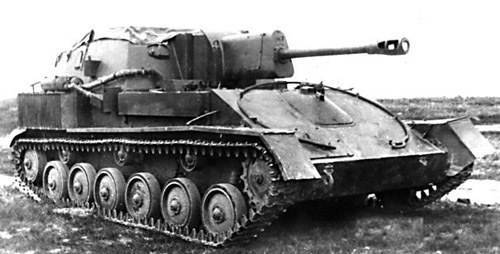
STORM CORD
The new ACS appeared as a result of a competition announced by the leadership of NKTP to create a light assault artillery missile with a 76-mm divisional gun. GAZ and Plant No. 38 took part in the competition.
Gorky people proposed the project SAU GAZ-74 on the chassis of the light tank T-70. The car was supposed to be equipped with one ZIS-80 engine or American GMC and to equip X-NUMX-mm C-76 cannon, developed on the basis of the F-1 tank gun.
At plant No. 38 they decided to use the engine unit GAZ-203 from the T-70 tank, consisting of two GAZ-202 engines connected in series, as a power plant. Previously, the use of this unit on the ACS was considered unacceptable because of its great length. Now, this problem has been tried to be eliminated due to a more careful layout of the fighting compartment, changes in the design of a number of units, in particular, a gun installation.
The gun ZIS-3 on the new machine SU-15 was mounted without the lower machine. At SU-12, this gun was installed with minimal changes, not only with the lower machine, but also with the cut-off beds (on machines of later releases, they were replaced with special spacers) that rested against the sides. On the SU-15 from the field gun, only the swinging part and the upper machine were used, which was mounted on a transverse U-shaped beam riveted and welded to the sides of the fighting compartment. The conning tower was still closed.
In addition to SU-15, plant number 38 offered two more machines - SU-38 and SU-16. Both of them were distinguished by the use of the standard base of the T-70 tank, and the SU-16, in addition, by the combat compartment, opened from above.
Tests of new artillery ships were conducted at the Gorokhovetsky testing ground in July 1943, at the height of the Battle of Kursk. The SU-15 enjoyed the greatest success with the military, and it was recommended for mass production after some modifications. It was necessary to facilitate the car, which was done by removing the roof. This simultaneously solved all the problems with ventilation, and also facilitated the embarkation and disembarkation of the crew. In July, the 1943-i SU-15 under the army designation SU-76М was adopted by the Red Army.
According to the layout of the SU-76M belonged to the type of semi-closed self-propelled units. The driver was sitting in the forward part of the hull along its longitudinal axis in the control compartment, which was located behind the transmission compartment. In the aft part of the hull there was a fixed open-top and partially behind the armored cabin in which the combat compartment was located. The ACS hull and deckhouse were welded or riveted from rolled armor plates 7 – 35 mm thick, installed at different angles of inclination. The underrun reservation of the gun had a thickness of 10 mm. For landing the driver in the upper front hull sheet served as a hatch closed with a cast armor cover with a periscope observation device borrowed from the T-70M tank.
To the left of the gun was the gunner of the gun, to the right, the unit commander. The charger was located in the left rear part of the combat compartment, the door in the stern sheet of which was intended for the landing of these crew members and the loading of ammunition. From precipitation, the fighting compartment was covered with a canvas awning.
A box-shaped crossbar was welded in front of the fighting compartment, in which the support of the upper machine 76-mm gun ZIS-3 of model 1942 of the year was attached. She had a wedge vertical shutter and semiautomatic copier type. The length of the gun was 42 caliber. The pointing angles are from -5о to + 15о vertically, 15о left and right horizontally. For direct fire and from closed positions, a regular periscope sight of the gun was used (Hertz panorama). The rate of fire of the cannon with correction of aiming reached 10 rds / min, with a runaway fire - up to 20 rds / min. The maximum firing range was 12 100 m, direct firing distance - 4000 m, direct shot - 600 m. Balancing the armor of the swinging part of the gun was carried out using the 110-kilogram counterweight, attached to the cradle from the bottom behind.
Ammunition guns included 60 unitary shots. An armor-piercing tracer with a mass of 6,5 kg had an initial speed of 680 m / s, at the distances 500 and 1000 m it pierced along the normal armor with a thickness of 70 and 61 mm, respectively. An armor-piercing projectile with a mass of 3 kg and an initial speed of 960 m / s at distances 300 and 500 m punched 105-mm and 90-mm armor.
The auxiliary armament of the SU-76M consisted of an 7,62-mm DT machine gun, which was transported in the fighting compartment. For firing from it were used closures with armored gates embrasures in the sides of the cabin and in its front sheet to the right of the gun. Ammunition DT - 945 cartridges (15 drives). In the fighting compartment, two PPSh submachine guns, 426 cartridges for them (6 discs) and 10 hand grenades F-1 were also placed.
In the middle part of the hull, in the engine compartment, the GAZ-203 power unit was mounted closer to the right-hand side - two 6-cylinder carburetor engines GAZ-202 connected in series, with a total power of 140 l. with. The crankshafts of the engines were connected by a coupling with elastic bushings. The ignition system, lubrication system and power system (except tanks) for each engine were independent. In the air cleaning system of the engines, two dual inertial-oil type air cleaners were used. The capacity of two fuel tanks located in the control compartment is 412 liters.
The SAU transmission consisted of a two-disk main friction clutch for dry friction, a four-speed ZIS-5 gearbox, a final drive, two multi-disk clutches with floating band brakes and two final drives.
In the undercarriage of the machine in relation to one board consisted of six rubberized rollers, three supporting rollers, front-wheel drive with a removable toothed crown and a guide wheel, similar in structure to the supporting roller. Suspension - individual torsion bar. The finely-divided caterpillar of the cogwheel engagement included an 93 track 300 mm wide.
Combat weight of the machine - 10,5 tons. The maximum speed instead of the calculated 41 km / h was limited to 30 km / h, since with its increase the beating of the left axle of the main gear began. Cruising range: 320 km - on the highway, 190 km - on a dirt road.
In the autumn of 1943, after the complete cessation of the production of T-70 light tanks, GAZ and Plant No. 76 in Mytishchi near Moscow were connected to production of the SU-40М. From 1 in January 1944, the Gorky Automobile Plant became the head enterprise for SU-76M, and NA Astrov was appointed the main designer of the ACS. Since his leadership at GAZ, since the autumn of 1943, work has been carried out to improve the self-propelled gun and to adapt its design to the conditions of mass production. Changes were made in the design of the SU-76M and in the future. For example, later-release machines received a high stern sheet of a fighting compartment with two embrasures and a larger door; a pipe welded to its right and left sides appeared for attaching a machine gun in the aft part of the wheelhouse; more suitable for shooting from a machine gun, etc.
Serial production of the SU-76M continued until the 1946 year. A total of 13 732 self-propelled guns of this type were released, including 11 494 - before the end of the Great Patriotic War.
SU-76M, like its predecessor SU-76, entered into service several dozen light self-propelled artillery regiments formed during the war years. At the beginning of 1944, the creation of self-propelled artillery divisions began (each had 12 first, and later 16 SU-76М). They replaced in several dozen infantry divisions separate anti-tank anti-tank divisions. At the same time the formation of light self-propelled artillery brigades RVGK. In these formations, there were 60 SU-76M units, five T-70 tanks and three American Scout MXXUMX-3 armored personnel carriers. In total, the Red Army had four such brigades.
FROM “FEMALES” TO “COLOMBINES”
Speaking of the combat use of the SU-76M, it should be emphasized that at the initial stage, these self-propelled guns, like all the others, were used rather illiterately, mostly as tanks. Most of the commanders of tank and combined-arms units had no idea about the tactics of the actions of self-propelled artillery and often sent regiments to the SAU literally for slaughter. The improper use, as well as the fact that at first the crews of artillery ships were staffed by former tank crews (the comparison between the tank and the lightly armored SAU was clearly not in favor of the latter), caused a negative attitude towards the SU-76, which found its expression in the soldiers' folklore. “Mass grave for four”, “pukalka”, “old girl” - these were still the softest nicknames. In the hearts of the soldiers called the SU-76M "bitch" and "naked" "Ferdinand"!
However, over time, the attitude to this machine has changed. Firstly, the tactics of the application changed, and secondly, the crews who did not have a tank past looked at their cars in a completely different way. They did not consider it a disadvantage, for example, the absence of a roof. On the contrary - thanks to this, observation of the terrain was facilitated, it became possible to breathe normally (ventilation, as is known, was a big problem for Soviet tanks and closed SAU), it was possible to conduct long-term intensive shooting without the risk of suffocation. At the same time, in contrast to the ZIS-3 field gun, the calculation of SU-76М was not affected by the armor from the sides and partially behind by bullets and fragments. In addition, the lack of a roof made it possible for the crew, at least to those of its members who were in the fighting compartment, to quickly leave the car when it failed. Alas, the driver was a hostage in such a situation. Best of all protected, he also died more often than other self-propelled guns.
The advantages of SU-76М include good maneuverability and low-noise travel, reliability in operation (the GAZ-203 unit confidently worked out 350 hours without serious damage), and most importantly, the machine’s wide versatility. Light self-propelled guns were involved in counter-battery fighting, infantry support in defense and offensive, fighting tanks, etc. They coped with all these tasks. The combat qualities of the SU-76M were particularly in demand at the final stage of the war. Fast and nimble, bristling with captured machine guns, SU-76М were often included in the forward squads while pursuing a retreating enemy.
Together with the attitude has changed and folklore, reflected in the nicknames and names of combat vehicles: “swallow”, “bold”, “snowflake”. SU-76M began to be called "rusk" and very highly aesthetic, "colombina".
SU-76M became the second most popular Soviet armored combat vehicle of the Great Patriotic War. Only the thirty-fours went to the Red Army!
Light self-propelled guns were in service with the Soviet army until the early 50s. The last arena of their combat use was Korea. By the beginning of the war that broke out here 55 years ago, there were several dozen SU-76Ms in the DPRK troops. The Chinese "people's volunteers" also had these machines. However, the use of the SU-76M on the Korean peninsula was not accompanied by great success. Low level of crew training, enemy superiority in tanks, artillery and aviation led to the fact that the SU-76M were quickly knocked out. Losses, however, were made up by supplies from the USSR, and by the end of the confrontation the North Korean units had 127 self-propelled guns of this type.
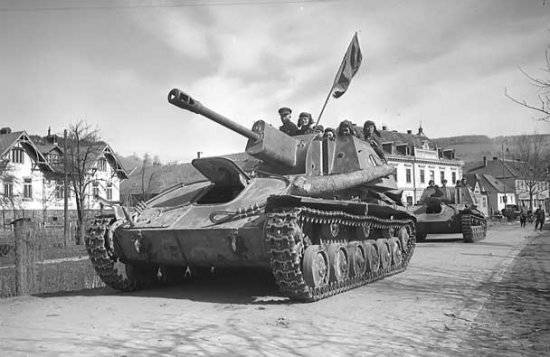
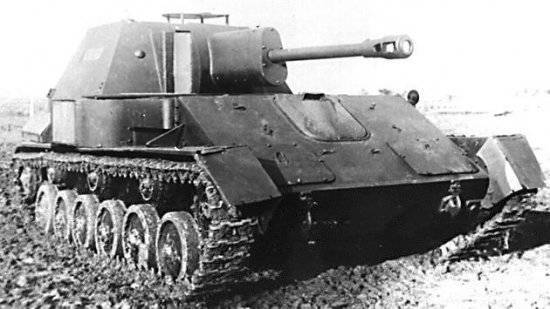
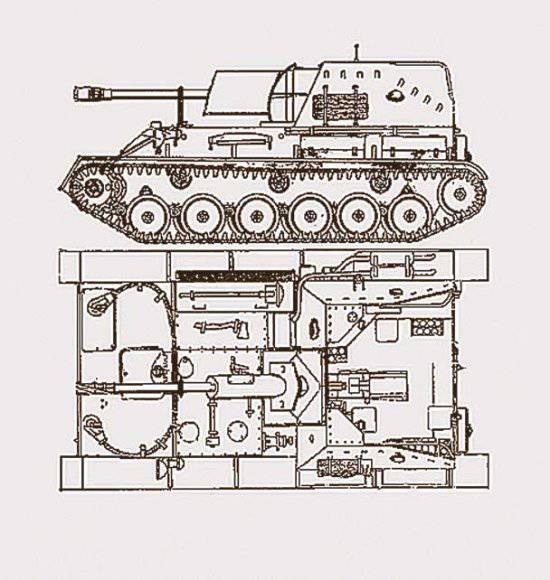
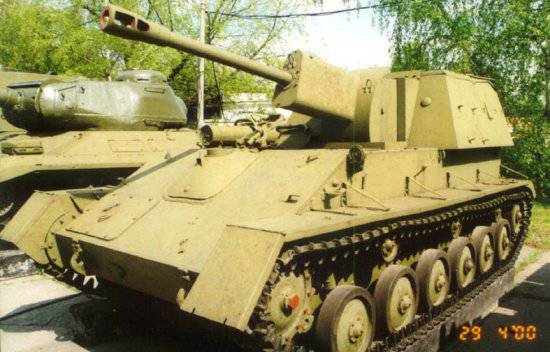

Information